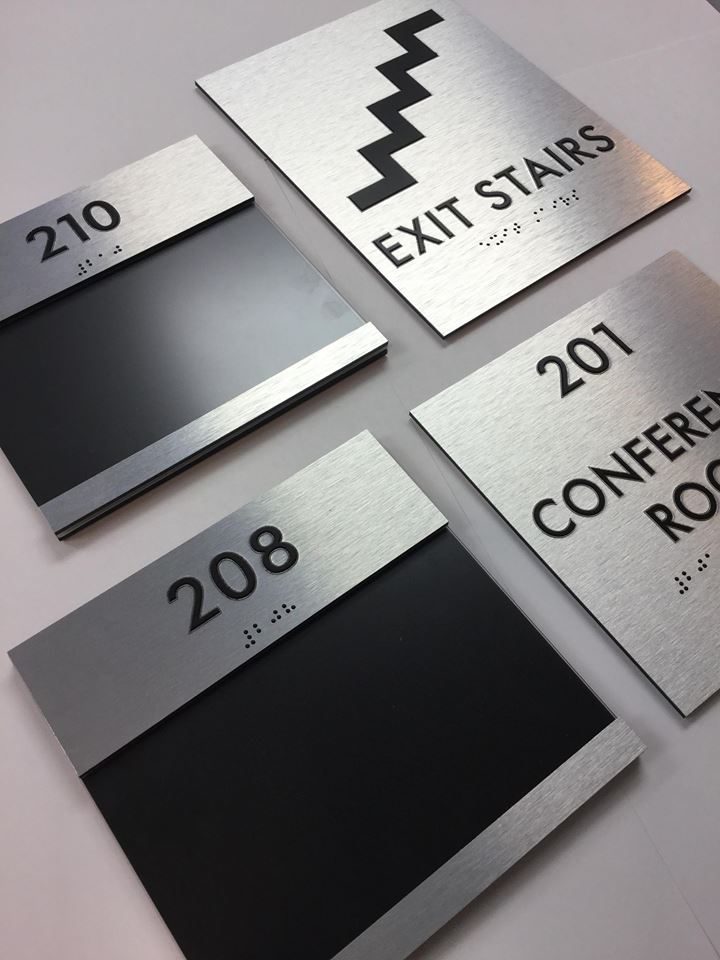ADA Signs: Necessary Devices for Inclusive Atmospheres
ADA Signs: Necessary Devices for Inclusive Atmospheres
Blog Article
Exploring the Secret Features of ADA Signs for Enhanced Access
In the realm of ease of access, ADA indications offer as quiet yet effective allies, making sure that spaces are inclusive and navigable for individuals with impairments. By incorporating Braille and tactile elements, these indications break obstacles for the visually damaged, while high-contrast shade systems and legible fonts provide to varied visual needs.
Importance of ADA Compliance
Ensuring compliance with the Americans with Disabilities Act (ADA) is important for promoting inclusivity and equivalent accessibility in public areas and work environments. The ADA, established in 1990, mandates that all public facilities, employers, and transportation services fit people with handicaps, guaranteeing they take pleasure in the very same civil liberties and chances as others. Conformity with ADA criteria not only meets legal commitments but additionally enhances a company's credibility by demonstrating its commitment to variety and inclusivity.
One of the crucial facets of ADA compliance is the execution of easily accessible signs. ADA indicators are made to guarantee that individuals with impairments can quickly browse via buildings and areas. These indicators have to abide by particular guidelines concerning size, font, color comparison, and positioning to assure exposure and readability for all. Properly applied ADA signs helps remove barriers that individuals with specials needs typically encounter, consequently promoting their independence and confidence (ADA Signs).
Moreover, adhering to ADA regulations can minimize the danger of legal repercussions and prospective penalties. Organizations that fail to follow ADA standards might encounter suits or penalties, which can be both destructive and financially burdensome to their public photo. Therefore, ADA conformity is integral to fostering a fair atmosphere for everybody.
Braille and Tactile Components
The incorporation of Braille and tactile aspects into ADA signage symbolizes the principles of ease of access and inclusivity. It is typically put underneath the matching text on signage to ensure that people can access the details without aesthetic help.
Responsive components prolong beyond Braille and consist of elevated personalities and signs. These components are made to be noticeable by touch, permitting people to identify space numbers, toilets, exits, and various other important areas. The ADA sets details standards concerning the size, spacing, and positioning of these responsive components to optimize readability and make sure consistency throughout various settings.

High-Contrast Color Design
High-contrast color schemes play a crucial role in improving the exposure and readability of ADA signage for people with aesthetic impairments. These plans are necessary as they make best use of the difference in light reflectance in between message and background, making certain that signs are quickly discernible, also from a range. The Americans with Disabilities Act (ADA) mandates making use of specific color contrasts to suit those with limited vision, making it a vital facet of compliance.
The efficiency of high-contrast shades lies in their capacity to stand out in various illumination problems, including dimly lit environments and locations with glow. Usually, dark text on a light history or light message on a dark history is utilized to accomplish ideal contrast. Black message on a yellow or white background provides a raw visual difference that assists in quick recognition and comprehension.

Legible Fonts and Text Dimension
When taking into consideration the design of ADA signage, the option of understandable fonts and proper text size can not be overstated. These components are essential for making certain that signs are available to individuals with visual impairments. The Americans with Disabilities Act (ADA) mandates that typefaces need to be not italic and sans-serif, oblique, manuscript, very ornamental, or of uncommon form. These requirements assist ensure that the text is easily readable from a distance which the characters are distinct to diverse target markets.
According to ADA standards, the minimum message height ought to be 5/8 inch, and it ought to raise proportionally with viewing range. Consistency in text dimension adds to a cohesive aesthetic experience, helping people in browsing environments successfully.
Moreover, spacing in between letters and lines is essential to clarity. Sufficient spacing stops characters from appearing crowded, enhancing readability. By sticking to these requirements, designers can substantially enhance accessibility, guaranteeing that signage serves its intended purpose for all individuals, no matter of their visual capacities.
Effective Placement Techniques
Strategic positioning of ADA signage is crucial for taking full advantage of ease of access and ensuring compliance with legal criteria. ADA standards state that indicators ought to be installed at a height in between 48 to 60 inches from the ground to guarantee they are within the line of view for both standing and seated individuals.
Furthermore, signs must be put nearby to the latch side of doors to permit very easy identification before access. Uniformity in sign positioning throughout a center boosts predictability, lowering confusion and boosting total customer experience.

Conclusion
ADA indications play an essential role in promoting access by integrating features that address the demands of people with impairments. These aspects jointly foster an you could try this out inclusive atmosphere, underscoring the relevance of ADA compliance in making sure equal accessibility for all.
In the realm of ease of access, ADA signs serve as silent yet effective allies, making sure that spaces are comprehensive and accessible for people with disabilities. The ADA, established in 1990, mandates that all public centers, employers, and transport solutions see it here fit people with specials needs, ensuring they enjoy the very same legal rights and opportunities as others. ADA Signs. ADA indicators are created great post to read to ensure that people with impairments can easily navigate with structures and rooms. ADA standards specify that indicators should be installed at a height between 48 to 60 inches from the ground to guarantee they are within the line of sight for both standing and seated people.ADA indicators play a vital duty in advertising ease of access by incorporating features that deal with the demands of people with handicaps
Report this page